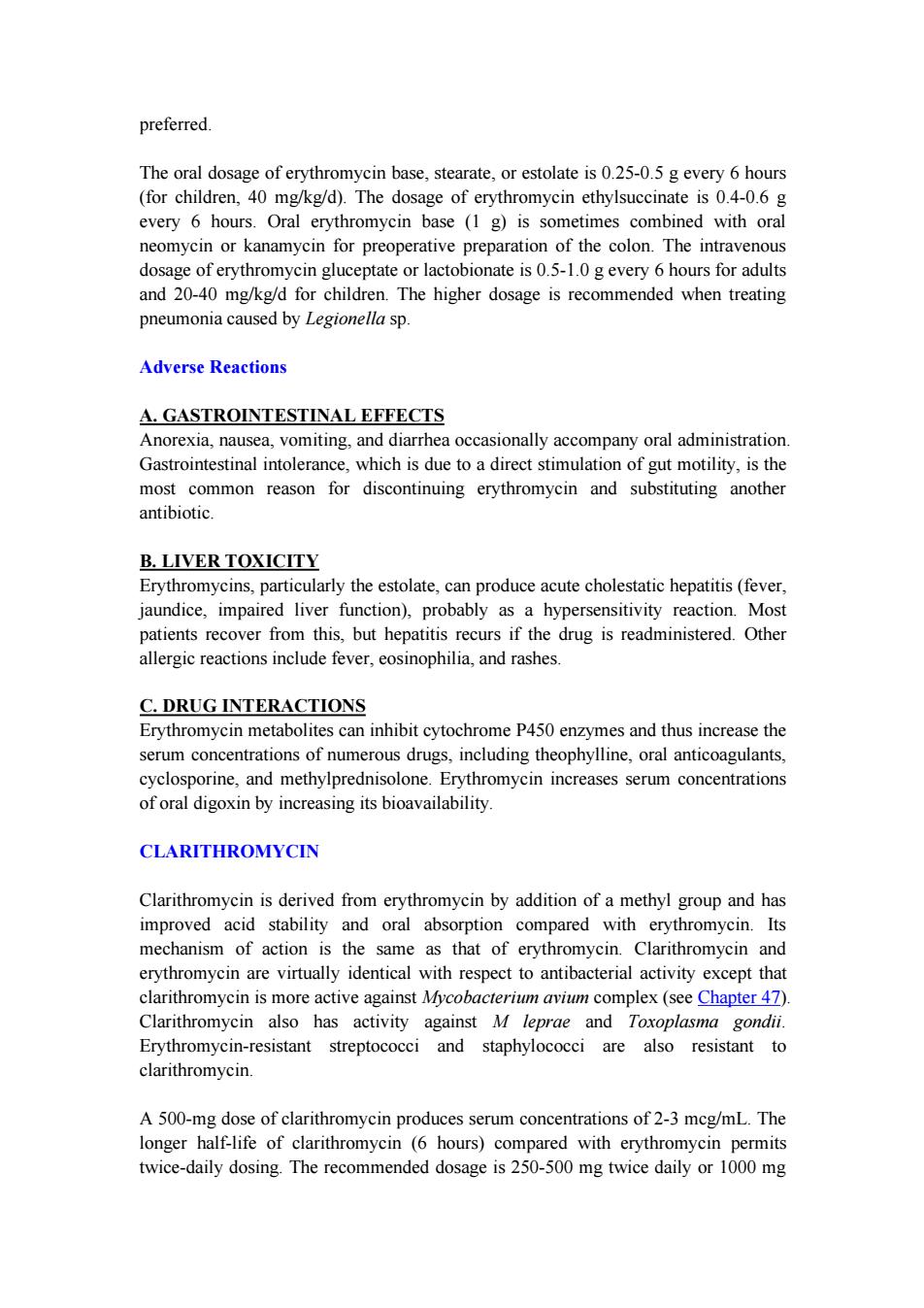正在加载图片...

preferred. The oral dosage of erythromycin base,stearate,or estolate is 0.25-0.5 g every 6 hours (for children,40 mg/kg/d).The dosage of erythromycin ethylsuccinate is 0.4-0.6 g every 6 hours.Oral erythromycin base (1 g)is sometimes combined with oral neomycin or kanamycin for preoperative preparation of the colon.The intravenous dosage of erythromycin gluceptate or lactobionate is 0.5-1.0 g every 6 hours for adults and 20-40 mg/kg/d for children.The higher dosage is recommended when treating pneumonia caused by Legionella sp. Adverse Reactions A.GASTROINTESTINAL EFFECTS Anorexia,nausea,vomiting,and diarrhea occasionally accompany oral administration. Gastrointestinal intolerance,which is due to a direct stimulation of gut motility,is the most common reason for discontinuing erythromycin and substituting another antibiotic. B.LIVER TOXICITY Erythromycins,particularly the estolate,can produce acute cholestatic hepatitis(fever, jaundice,impaired liver function),probably as a hypersensitivity reaction.Most patients recover from this,but hepatitis recurs if the drug is readministered.Other allergic reactions include fever,eosinophilia,and rashes. C.DRUG INTERACTIONS Erythromycin metabolites can inhibit cytochrome P450 enzymes and thus increase the serum concentrations of numerous drugs,including theophylline,oral anticoagulants, cyclosporine,and methylprednisolone.Erythromycin increases serum concentrations of oral digoxin by increasing its bioavailability. CLARITHROMYCIN Clarithromycin is derived from erythromycin by addition of a methyl group and has improved acid stability and oral absorption compared with erythromycin.Its mechanism of action is the same as that of erythromycin.Clarithromycin and erythromycin are virtually identical with respect to antibacterial activity except that clarithromycin is more active against Mycobacterium avium complex (see Chapter 47). Clarithromycin also has activity against M leprae and Toxoplasma gondii. Erythromycin-resistant streptococci and staphylococci are also resistant to clarithromycin. A 500-mg dose of clarithromycin produces serum concentrations of 2-3 mcg/mL.The longer half-life of clarithromycin (6 hours)compared with erythromycin permits twice-daily dosing.The recommended dosage is 250-500 mg twice daily or 1000 mgpreferred. The oral dosage of erythromycin base, stearate, or estolate is 0.25-0.5 g every 6 hours (for children, 40 mg/kg/d). The dosage of erythromycin ethylsuccinate is 0.4-0.6 g every 6 hours. Oral erythromycin base (1 g) is sometimes combined with oral neomycin or kanamycin for preoperative preparation of the colon. The intravenous dosage of erythromycin gluceptate or lactobionate is 0.5-1.0 g every 6 hours for adults and 20-40 mg/kg/d for children. The higher dosage is recommended when treating pneumonia caused by Legionella sp. Adverse Reactions A. GASTROINTESTINAL EFFECTS Anorexia, nausea, vomiting, and diarrhea occasionally accompany oral administration. Gastrointestinal intolerance, which is due to a direct stimulation of gut motility, is the most common reason for discontinuing erythromycin and substituting another antibiotic. B. LIVER TOXICITY Erythromycins, particularly the estolate, can produce acute cholestatic hepatitis (fever, jaundice, impaired liver function), probably as a hypersensitivity reaction. Most patients recover from this, but hepatitis recurs if the drug is readministered. Other allergic reactions include fever, eosinophilia, and rashes. C. DRUG INTERACTIONS Erythromycin metabolites can inhibit cytochrome P450 enzymes and thus increase the serum concentrations of numerous drugs, including theophylline, oral anticoagulants, cyclosporine, and methylprednisolone. Erythromycin increases serum concentrations of oral digoxin by increasing its bioavailability. CLARITHROMYCIN Clarithromycin is derived from erythromycin by addition of a methyl group and has improved acid stability and oral absorption compared with erythromycin. Its mechanism of action is the same as that of erythromycin. Clarithromycin and erythromycin are virtually identical with respect to antibacterial activity except that clarithromycin is more active against Mycobacterium avium complex (see Chapter 47). Clarithromycin also has activity against M leprae and Toxoplasma gondii. Erythromycin-resistant streptococci and staphylococci are also resistant to clarithromycin. A 500-mg dose of clarithromycin produces serum concentrations of 2-3 mcg/mL. The longer half-life of clarithromycin (6 hours) compared with erythromycin permits twice-daily dosing. The recommended dosage is 250-500 mg twice daily or 1000 mg